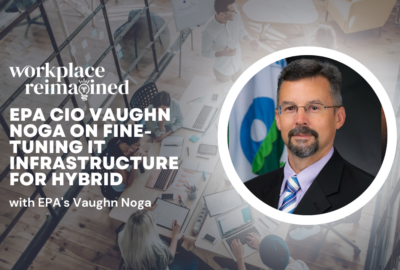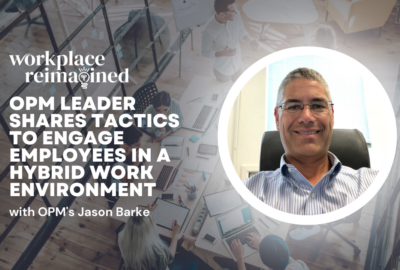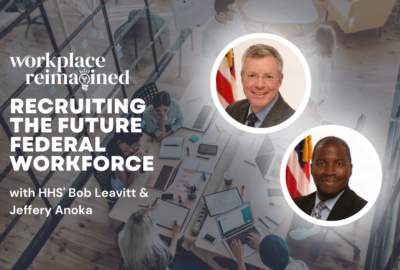Insight by Verizon
Workplace Reimagined 2023: Verizon’s Sunil Rajan on laying the foundation for a long-term hybrid federal workforce
Since the government moved swiftly in the wake of the pandemic to continue services, it now must reevaluate what’s required to support a hybrid workforce long...
Federal agencies that rushed to make remote work possible at the height of the COVID-19 pandemic are now laying the foundation for long-term workplace flexibilities for federal employees.
Agencies are navigating many challenges as they embrace a long-term hybrid workforce, said Sunil Rajan, managing client partner and digital experience enablement leader for public sector at Verizon told Federal News Network during Workplace Reimagined 2023.
“The key takeaway from a trend standpoint is we’re all figuring this out, both private sector and public sector,” he said. “We’ve seen employees benefit from a work from home model. We’ve seen government services not get disrupted in the last three years. So it’s a tough case to bring them back to the work environment.”
While the Office of Management and Budget is directing agencies to “substantially increase meaningful in-person work at federal offices,” particularly at headquarters in the D.C. metro area, federal employees are still reaping the benefits of workplace flexibilities.
Does a hybrid federal workforce deliver cost savings?
The Office of Personnel Management, in its fiscal 2021 telework status report, estimated agencies saved about $90 million that year because of lower transit costs, reduced absences and less spending on utilities and office space.
OPM also found employees reported significantly improved satisfaction ratings, in terms of better work-life balance, and a higher level of interest in employees staying in their jobs.
“With that comes better employee retention and all of the benefits that you see from a hybrid working model,” Rajan said. “Coupled with the fact that government services continued in the pandemic era, it’s quite a difficult case to move back to an entirely in the office model.”
What’s required to support a far-flung workforce?
The shift to a hybrid workforce — and, in some cases, remote work — has allowed agencies in the Washington, D.C., region to recruit employees beyond the metro area. But Rajan said agencies need to prioritize IT modernization and digital transformation to support a hybrid workforce long term.
“If you have an employee sitting in, let’s say, the middle of Arizona and working for the federal government, without the right collaboration and communication capabilities and technology to be productive, it’s going to be extremely difficult,” he said.
Agencies, at the onset of the pandemic, scrambled to make the IT upgrades that would be necessary to support continuity of government operations. Now, they need to make longer-term, strategic IT investments, Rajan said.
“As we’re coming out of the pandemic, CIOs are looking to build and create a more scalable and sustainable model from a technology standpoint,” he said.
Agencies are now focusing their latest wave of tech investments on securing the connection of teleworking employees as they remotely access government data centers or the cloud.
“We at Verizon are having a number of conversations with our customers, in terms of our ability to help not only secure the devices but secure the connectivity, monitor the connectivity, control what can and cannot be done with that connectivity — to make it a more secure ecosystem, irrespective of where you’re working from,” he said.
Does a hybrid model help agencies hire and keep talent?
Pandemic-era workplace flexibilities have also transformed how the federal government recruits and retains employees.
Agencies see workplace flexibilities as a useful incentive when recruiting the next generation of federal employees. Rajan said about 27% of the U.S. population is between the ages of 20 and 40, and that younger generation entering the workforce possesses in-demand technology skills. But they also expect a different work-life balance than previous working generations.
“In order to attract and retain and manage that talent, the government is not only going to be competing with the private enterprises, from a tech savviness and compensation standpoint, but now also this whole idea of enabling a remote work environment,” Rajan said.
Younger generations are also setting a higher bar for public-facing customer experiences across government. Rajan said people now expect to have a simpler, digital-first experience with government services.
What must agencies do to create better customer experiences?
To deliver on these changing expectations, Rajan said agencies must improve the “total experience” — building a better experience for their employees and contractors while also optimizing the experience for individuals seeking government benefits and or interacting with federal programs.
“How do you give a citizen the right digital experience so that they can perform self-service capabilities, leverage bots to understand and get information quickly, rather than being on the phone, on hold and waiting for a person on the back end to answer?” Rajan said.
As agencies reimagine workplace expectations for their employees, federal executives need to set a clear vision for the future of the government workforce as well as roadmap for necessary technology to support that vision, he suggested.
“Change is never easy. Change has never been easy. And I don’t think it’ll ever be easy. But having that top-level buy-in and commitment to your strategy, to your vision, to your objectives, and then a top-down commitment to encourage your organization to go through that change is going to be fundamental,” Rajan said.
To watch and read more from 2023 Workplace Reimagined, visit our event page.
Copyright © 2025 Federal News Network. All rights reserved. This website is not intended for users located within the European Economic Area.
Related Stories
Featured speakers
-

Sunil Rajan
Managing Client Partner and Digital Experience Enablement Leader for Public Sector, Verizon
-

Jory Heckman
Reporter, Federal News Network
Upcoming Events
Related Stories
Top Stories

Sunil Rajan
Managing Client Partner and Digital Experience Enablement Leader for Public Sector, Verizon

Jory Heckman
Reporter, Federal News Network
Jory Heckman has been a reporter at Federal News Network since January 2018. Jory got his start as an intern in 2011 and was a digital news writer and editor for Federal News Network from 2014 to 2018. He also worked as a desk assistant with CBS News Radio in New York and was a reporter for the Citizens’ Voice newspaper in Wilkes-Barre, Pennsylvania.






